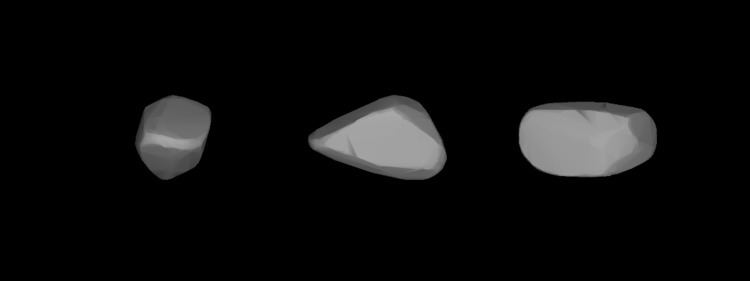Discovered by C. A. Wirtanen MPC designation 1747 Wright Minor planet category Mars-crosser Absolute magnitude 13.35 Discoverer Carl A. Wirtanen | Discovery date 14 July 1947 Alternative names 1947 NH Discovered 14 July 1947 Orbits Sun | |
 | ||
Named after William Wright(observatory's director) Similar Sun, 1685 Toro, (29075) 1950 DA, 46P/Wirtanen | ||
1747 Wright, provisional designation 1947 NH, is a stony asteroid and a sizable Mars-crosser, approximately 6 kilometers in diameter. It was discovered on 14 July 1947, by American astronomer Carl Wirtanen at Lick Observatory on Mount Hamilton near San Jose, California.
The S-type asteroid is classified as an AU and Sl-type in the respective Tholen and SMASS classification scheme. It orbits the Sun at a distance of 1.5–1.9 AU once every 2 years and 3 months (816 days). Its orbit has an eccentricity of 0.11 and an inclination of 21° with respect to the ecliptic. As no precoveries were taken and no previous identifications were made, Wright's observation arc begins with its discovery observation in 1947.
According to the surveys carried out by the Infrared Astronomical Satellite IRAS and the Japanese Akari satellite, the asteroid measures 5.17 and 6.35 kilometers in diameter and its surface has an albedo of 0.20 and 0.32, respectively. The Collaborative Asteroid Lightcurve Link agrees with the results obtained by IRAS.
In July 2005, a rotational light-curve for this asteroid was obtained by astronomers Reiner Stoss, Jaime Nomen, Salvador Sánchez and Raoul Behrend at the Mallorca Observatory, Spain. It gave a well-defined rotation period of 7000528960000000000♠5.2896±0.0002 hours with a brightness variation of 0.61 magnitude (U=3). In July 2014, another, concurring light-curve with a period of 7000528796000000000♠5.28796±0.00005 hours and an amplitude of 0.53 was obtained by Robert D. Stephens at the Center for Solar System Studies (CS3, U81) in Landers, southern California.
The minor planet was named in memory of American astronomer William Hammond Wright (1871–1959), staff member and later director of the Lick Observatory until 1942. A pioneer in astrophysics, his large, wide-field 20-inch Carnegie double astrograph built for the observatory's proper motion survey (first light in 1941), was using distant galaxies ("spiral nebulae") as object references. During this survey, many comets and asteroids were discovered as a by-product. He is also honored by the Martian and lunar craters Wright. Naming citation was published before November 1977 (M.P.C. 3934).
